The Raj
- This was a group of of British scholars who settled in India when they took control of it.
John Marshall
- A member of the Raj, this man held the belief that Indian art and civilization was influenced and started by the Aryan race.
R.D. Bannerji
- R.D. was an Indian scholar who was taught by John Marshall. He disagreed with the Raj point of view and found proof that Indian civilization existed before 323 BC.
Ananda Coomarswamy
- He was a student of Bannerji who disagreed with the Raj on the basis of the influence of Indian monumental structure. He also explored the dual interpretation of Buddhism.
Friedrich Wolfgang Hegel
- While he wasn't an art historian, he did come up with a principle that helped to explain a controversial question on the origin of Hinduism.
Alicia Matsunaga
- Matsunaga was the student of Ananda Coomarswamy and based her ideas from Friedrich Wolfgang Hegel. She came up with an interesting idea on how Buddhism brought about the major religion of Hinduism.
- This was a group of of British scholars who settled in India when they took control of it.
Ideas They Raised
Raj View of Indian Civilization
By reading such documents as the Anabasis, Hastings as well as the rest of the Raj scholars came to the conclusion that Indian civilization began with the invasion of Alexander the Great in 323 BC.Bannerji's Counter
Although the people taught him, R.D. Bannerji disagreed with the Raj's view on the development of his civilization. Bannerji was so convinced of this, that he dug up the Indus Valley site and found the two cities Harrappa and Mohenjo Daro. There he found all sorts of artifacts and evidence of an intelligent civilization such as reproduced bricks, ventillation, and a sewer system. Unfortunately he destroyed the straitigraphy of the site (which is the dating analysis done with dug up soil) so the only clue that he had to date it was a seal called Tel Ismar which dated back to 2300 BC. The Raj refuted this evidence and came up with another date, 1500 BC. This was the date of a great Aryan invasion of the Providians, dark skinned phallus worshipping people. This was based on documentation found in the Rg Veda. Bannerji let this setback slide for the time, but when he came back, he came back with new evidence. By analyzing the works of the two cities as well as the works of later eras he was able to connect the two civilizations as the same one. Such similarities included the Harrappa Torso and the Lohanipur Torso, which have the same limbs broken off. Instead of attacking the date, Bannerji was able to prove his point by attacking the similarities in the artwork.Raj View of Monumental Sculpture
The Raj were dumbfounded when they found Indian monumental sculpture. With no records of any kind of sculpture like this before the Maurya Period, the Raj concluded that it was the influence of Alexander the Great that brought about this sculpture. They believed that the lions on these capitals were as real as those of the Ancient Grecians.Coomarswamy's Counter
Like his teacher before him, Ananda Coomarswamy disagreed with the Raj view of the development of Indian monumental sculpture. First of all Coomarswamy found reason to believe that there is a lost culture of Indian wooden sculpture. He found proof of this by analyzing chaitya halls and stupas. A certain chaitya hall at Bhaja was completely carved into the side of a mountain. Carving is something that would traditionally be done to wood, but somehow these Indians were able to do the same thing to stone. Furthermore, the pillars here are slanted, which is typical of wooden sculpture. Another thing that is typical of wooden sculpture that show up in chaityas and stupas is the potted pillars that drown ants and termites that attempt to take residence in them. Wood rots easily so it is safe to say that this wooden culture is truely lost. Coomarswamy believed that Indians practiced with wood carving and later progressed to stone carving.Dual Interpretation of Buddhism
Coomarswamy also combated the Raj on the basis of the development of the Buddha figure. The Raj believed that the Buddha figure was inspired by Grecian influence, but Coomarswamy knew better after proving them wrong on their monumental sculpture theory. By falling back on his teacher's methods, he found out that there lay a dual interpretation of Buddha between the Buddhists and the Hindus. One such similarity is the yaksha figure and the Bodhisattva. The yaksha figure is a hindu figure but when the Friar Bola Bodhisattva came about it was worhipped as a yaksha by Hindus. The Bodhisattva is a result of the Hindu yaksha which is a result of such Indus Valley relics as the Harrappa Torso. Further intrpretations are as follows:| Indian Era | Works | Buddhist | hindu |
|---|---|---|---|
| Maurya Period (3rdc BC) | Sarnath Lion Capital |
|
|
| Sunga-Andra Period (1BC-1AD) | Stupas Chaityas |
|
|
| Kushan & Gupta Period (5thc AD) | Friar Bola Bodhisattva | Worshipped as a Buddha | Worshipped as a Yaksha |
Hegel's Rule
Friedrich Wolfgang Hegel came up with this interesting theory that if there is something in the begining that is mixed with another thing, those two will produce a completely new thing. Or in short:Thesis + Antithesis = Synthesis
Although it may not be wise to use this principle in every single case, art historians have been applying this principle for years to make sense of certain things. It may even be more correct to say:
Synthesis = Thesis & Antithesis
Buddhism to Hinduism
Alicia Matsunaga put Hegel's Rule to work in trying to combat a certain idea. There were some that said that India had no religion before Buddhism came in the 5th century AD. By looking at the old figures of the Indus Valley cities Harrappa and Mohenjo Daro, Matsunaga used the same method Bannerji used to connect old figures to later figures. Particularly she looked at figures such as the one leg up Dancer figure which was in the same pose as the Shiva Nataraja. By this proof she was convinced that the Indus Valley civilization worshipped the same gods as those worshipped by the Hindus. The only difference between the times before and after official Hinduism was that one time had Buddhism and the other did not. By applying Hegel's rule she came to the conclusion that Hinduism existed before Buddhism, it just didn't have a name because it didn't need to distinguish itself from any other religion. When Buddhism did arrive, these old beliefs had to be codified and distinguished from Buddhism. Thus, Hinduism was named."hinduism" + Buddhism => Hinduism & Buddhism
Monism
This is somewhat of a narrow-minded viewpoint that says that civilizations can only learn skills from other civilizations because they are incapable of doing these skills themselves. This was the idea that the Raj held for some time.Pluralism
This viewpoint states that different civilizations can unwittingly learn the same skills without any outside influence. Coomarswamy believed that this was the case concerning monumental sculpture.Works, Relics, and Places
Harrappa and Mohenjo Daro
These are the two excavated cities that R.D. Bannerji discovered at the Indus Valley site. The cities contain various works of Indian arts and tools that Bannerji used to prove that civilization existed in India before 323 BC.Stupa
Made during the Sunga-Andra Period, they served as temples for phallac, sun, and tree worship. Examples include the stupas at Sanchi and Bharhut.Chaitya Hall
This was also made during the Sunga Andra Period. The only difference between this and a stupa is that the chaitya hall is an indoor stupa. Examples include the chaitya at Bhaja and Karli.Friar Bala Bodhisattva
Friar Bala Bodhisattva is an example of a Bodhisattva which is some what of a "Buddha to be."Ashoka
He was said to be the first king of the Maurya Period. It was after him that the monumental pillars were named after.Chart of Art
| Indian Era | Various Works of Art and Culture |
|---|---|
| Indus Valley Period (3000 BC) | |
| Maurya Period (3rdc BC) | |
| Sunga-Andra Period (1BC-1AD) | |
| Kushan & Gupta Period (5thc AD) |
Monumental Sculptures
These are sculptures that were made some time during the Maurya Period of India.Sarnath Lion Capital
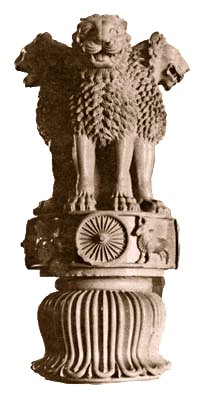
Rampurva Bull
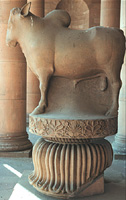
Sanchi Lion Capital
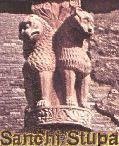
Lauriya Nandagarh Lion
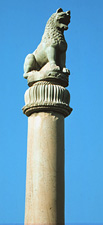
Relation to Prana
For centuries, Indians believed that all art should be full of Prana, "the swelling breath of life." Given that this is the popular tradition of Indian art it is clear to see what is meant by this. Almost every piece of Indian sculpture looks bloated or full of a lot of air. The faces of yaksha, yakshi, and Buddha figures appear as if they are puffing their cheeks out. This was another thing that disproved the Raj idea of Grecian influence in sculpture. Grecian sculpture looks life-like, but it lacks the fullness that Indian art possesses and has always possessed.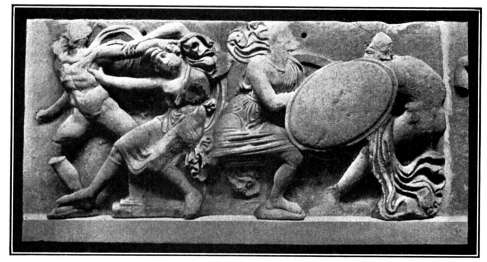
Sculpture of Amazons
 Eras of India
Eras of India
